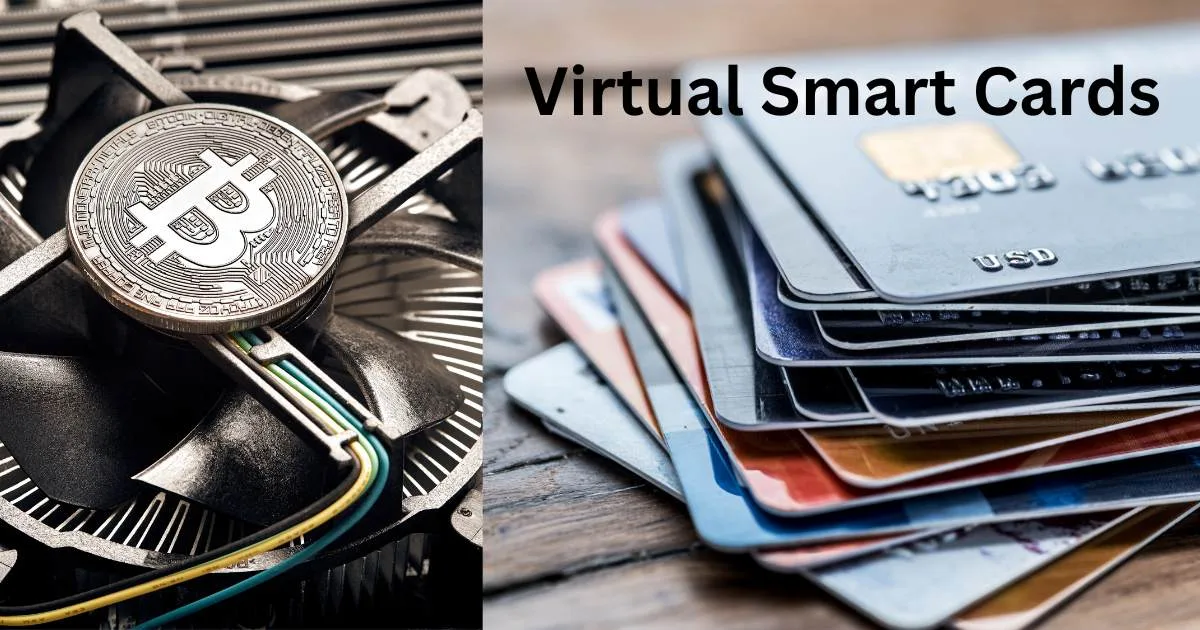Virtual Smart Cards (VSCs) play a crucial role in enhancing the security of digital systems and networks. They are essentially software-based simulations of physical smart cards, providing a secure environment for storing sensitive data such as cryptographic keys, and for performing secure cryptographic operations.

One of the key security components used to support virtual smart cards is the Trusted Platform Module (TPM). The TPM is a hardware-based security chip that is embedded in the computer’s motherboard. It provides a secure environment for storing and processing sensitive information, such as encryption keys and digital certificates.
Related: Best Home Security System Without Subscription
Another important security component used to support virtual smart cards is the Public Key Infrastructure (PKI). PKI is a set of technologies and protocols that enable secure communication over the Internet. It uses digital certificates to verify the identity of users and devices and to encrypt and decrypt sensitive information. By leveraging PKI, virtual smart cards can be securely deployed and managed across a wide range of devices and platforms.
Virtual Smart Cards: An Overview
Virtual smart cards are a type of smart card that are stored on a computer or other electronic device, rather than on a physical card. They are used to provide secure authentication and encryption for a variety of applications, including online banking, secure email, and secure remote access to corporate networks.

One of the key security components used to support virtual smart cards is the Trusted Platform Module (TPM). The TPM is a hardware-based security component that is built into many modern computers and other electronic devices. It provides a secure storage area for cryptographic keys and other sensitive data and can be used to generate and manage virtual smart cards.
When a user logs in to a system that uses virtual smart cards, the TPM generates a unique cryptographic key that is used to encrypt and decrypt data. This key is stored securely within the TPM and is protected by a variety of security measures, including physical tamper resistance and anti-tampering mechanisms.
Overall, virtual smart cards provide a powerful and flexible solution for secure authentication and encryption and are an important component of many modern security systems. By using the TPM to support virtual smart cards, organizations can ensure that their sensitive data remains secure, even in the face of sophisticated cyber attacks.
Basic Security Components
Virtual smart cards are used to provide secure authentication and access control in various scenarios. These virtual cards are stored on a user’s device and can be used to authenticate the user to a remote system or service. To support virtual smart cards, several basic security components are required.
-
Key storage mechanism
One of the most important security components is a secure key storage mechanism. Virtual smart cards require private keys to be stored securely on the user’s device. If the private keys are compromised, an attacker could impersonate the user and gain access to sensitive data or systems. Therefore, the key storage mechanism must be designed to prevent unauthorized access to the private keys.
-
Secure communication channel
Another important security component is a secure communication channel. When a user authenticates with a virtual smart card, the authentication data must be transmitted securely to the remote system or service. This requires a secure communication channel that encrypts the data in transit and ensures that it cannot be intercepted or modified by an attacker.
-
Secure boot process
In addition to key storage and secure communication, virtual smart cards also require a secure boot process. This ensures that the device is booted securely and that the virtual smart card is loaded into a trusted environment. This helps prevent attackers from tampering with the device or intercepting the authentication data.
Overall, these basic security components are essential for supporting virtual smart cards and ensuring that they provide secure authentication and access control. By implementing these components, organizations can improve their security posture and protect sensitive data and systems from unauthorized access.
Supporting Role of Security Components
Virtual smart cards are used as an alternative to physical smart cards. They are software-based and can be deployed on any device that supports them. Virtual smart cards are used to authenticate users and provide secure access to resources.
One of the basic security components used to support virtual smart cards is the Public Key Infrastructure (PKI). PKI is a set of policies, procedures, and technologies used to secure communication and provide authentication. PKI is used to manage the digital certificates that are used to authenticate users and devices.
Another security component used to support virtual smart cards is the Trusted Platform Module (TPM). TPM is a hardware-based security component that provides secure storage of cryptographic keys. TPM is used to store the private keys that are used to sign and decrypt data.
In addition to PKI and TPM, virtual smart cards also rely on secure boot and secure storage. Secure boot ensures that the operating system and boot loader are not tampered with during the boot process. Secure storage ensures that the virtual smart card and its associated keys are stored securely.
Overall, these security components play a critical role in supporting virtual smart cards. They ensure that the virtual smart card is secure and can be trusted for authentication and access control.
Key Storage and Encryption
Virtual smart cards rely on a secure key storage and encryption mechanism to ensure the confidentiality and integrity of the card’s private key. The private key is securely stored on the user’s device and is used to sign and decrypt sensitive data.
The key storage and encryption mechanism used to support virtual smart cards varies depending on the platform and implementation. However, most virtual smart card solutions use a combination of software and hardware-based encryption mechanisms to protect the private key.
-
Hardware-based encryption mechanisms
Hardware-based encryption mechanisms are typically more secure than software-based mechanisms as they rely on dedicated hardware components to perform cryptographic operations. These hardware-based mechanisms are often integrated into the device’s CPU or chipset and offer a high level of protection against attacks.
-
Software-based encryption mechanisms
Software-based encryption mechanisms, on the other hand, rely on the operating system and software to perform cryptographic operations. While software-based mechanisms are generally less secure than hardware-based mechanisms, they can still provide an adequate level of protection when implemented correctly.
In summary, the key storage and encryption mechanism used to support virtual smart cards is a critical component of the overall security of the solution. By using a combination of hardware and software-based encryption mechanisms, virtual smart card solutions can provide a high level of protection for the card’s private key.
Authentication Protocols
Authentication protocols are a crucial component of security systems that support virtual smart cards. These protocols are responsible for verifying the identity of a user attempting to access a system or resource.
There are several common authentication protocols used to support virtual smart cards, including:
-
Kerberos:
This protocol is widely used in enterprise environments and provides mutual authentication between a user and a server. It uses a ticket-based system to authenticate users and provides strong security through the use of encryption.
-
Smart Card Authentication:
This protocol uses a smart card to authenticate users and provides a high level of security. The smart card contains a private key that is used to sign authentication requests, ensuring that only authorized users can access the system.
-
Public Key Infrastructure (PKI):
This protocol uses digital certificates to authenticate users. The certificates are issued by a trusted authority and contain a public key that is used to encrypt and decrypt messages. PKI provides strong security and is widely used in enterprise environments.
Overall, authentication protocols are a critical component of security systems that support virtual smart cards. They provide strong security and ensure that only authorized users can access sensitive resources.
Secure Kernel
A Secure Kernel is a basic security component that supports virtual smart cards. It provides a trusted execution environment for security-sensitive applications and services.
The Secure Kernel is responsible for enforcing access control policies and protecting the system against unauthorized access and malicious attacks. It provides a secure boot process, secure storage for sensitive data, and secure communication channels between components.
In addition, the Secure Kernel provides a set of security APIs that enable developers to create secure applications and services that run within the trusted execution environment. These APIs include access control, cryptography, and secure communication functions.
The Secure Kernel is designed to be tamper-resistant and resistant to attacks such as buffer overflows, code injection, and privilege escalation. It uses a variety of techniques such as address space layout randomization, stack canaries, and data execution prevention to prevent these types of attacks.
Overall, the Secure Kernel is a critical component of a secure system that supports virtual smart cards. It provides a trusted execution environment that protects sensitive data and ensures the integrity and confidentiality of the system.
Hardware Security Module
A Hardware Security Module (HSM) is a physical device that provides secure storage and management of cryptographic keys and other sensitive data. It is commonly used to support virtual smart cards, which are software-based smart cards that can be used for authentication and other security purposes.
An HSM is designed to provide a high level of security for cryptographic operations, such as key generation, key storage, and key management. It is typically used in conjunction with other security components, such as smart cards or biometric authentication systems, to provide a comprehensive security solution.
HSMs are used in a wide range of applications, including financial transactions, digital signatures, and secure communications. They are also used to support virtual smart cards, which are becoming increasingly popular in enterprise environments.
Virtual smart cards are software-based smart cards that can be used for authentication and other security purposes. They are typically stored on a user’s computer or mobile device and can be used to access secure systems and applications.
To support virtual smart cards, an HSM is used to securely store and manage the cryptographic keys that are used to authenticate the user. The HSM provides a high level of security for these keys, ensuring that they cannot be compromised by attackers.
Overall, an HSM is an essential component of any comprehensive security solution. It provides a high level of security for cryptographic operations and is commonly used to support virtual smart cards in enterprise environments.
Conclusion
In conclusion, virtual smart cards are a useful security component that can be used to protect sensitive information and systems. They provide a secure way to store and use cryptographic keys, which are necessary for secure communication and authentication. One of the basic security components used to support virtual smart cards is the Trusted Platform Module (TPM).
The TPM is a hardware-based security component that provides a secure environment for cryptographic operations. It is typically used to store cryptographic keys and other sensitive information, such as passwords and digital certificates. The TPM can also be used to support virtual smart cards by providing a secure storage location for the virtual smart card’s private key.
Overall, the use of virtual smart cards and the TPM can help to improve the security of information and systems. By using these security components, organizations can ensure that only authorized users have access to sensitive information and systems and that cryptographic operations are performed securely and reliably.










